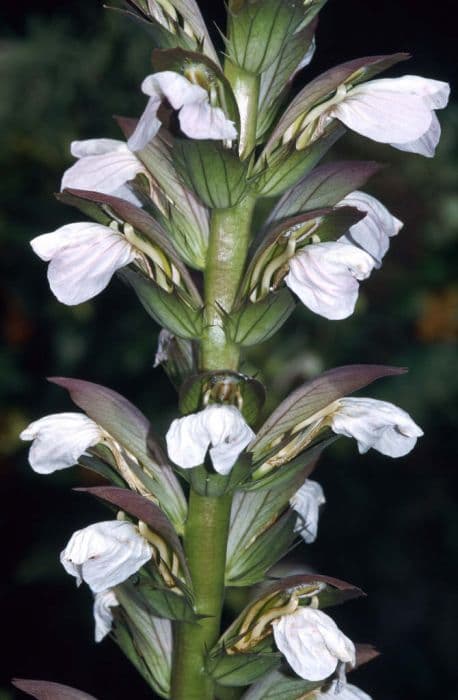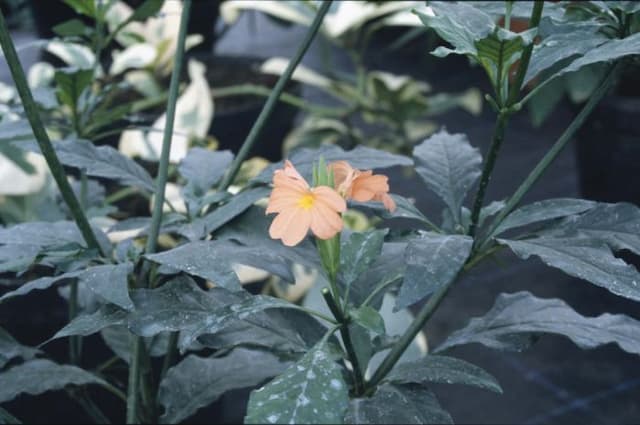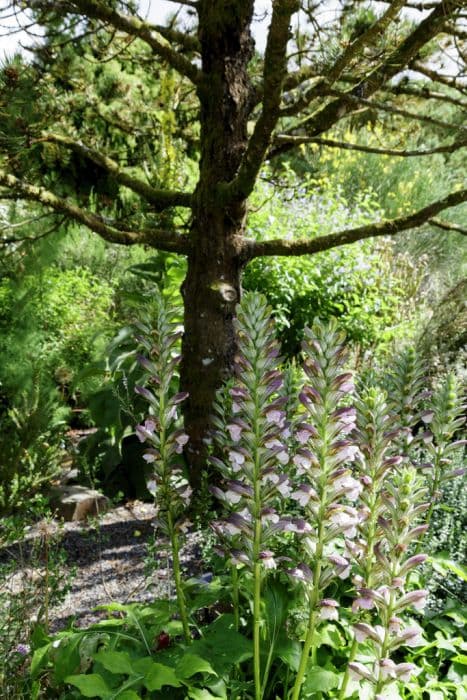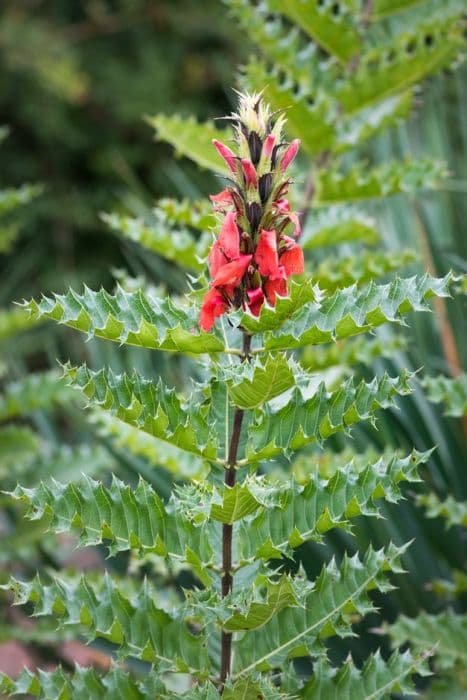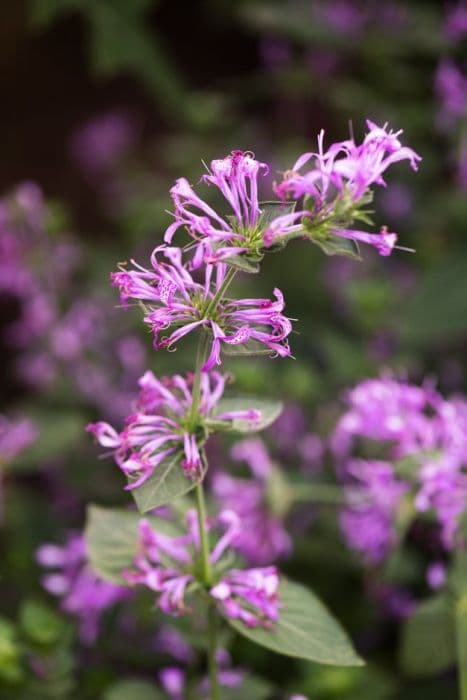Nerve plant Fittonia albivenis Argyroneura Group



ABOUT
Fittonia albivenis, also known as the Nerve plant or Mosaic plant, is a small, tropical perennial plant that is native to the rainforests of South America. It is known for its distinctive, colorful foliage that is often used as a groundcover or in hanging baskets.
Nerve plant has glossy, oblong leaves that are typically about 1-2 inches long and are arranged in pairs along the stem. The leaves are green on the top and have white, pink, or red veins running through them, giving them a distinctive, mosaic-like appearance. The leaves are also edged with a contrasting color, which can be white, pink, or red.
In addition to its attractive foliage, Fittonia albivenis also produces small, white or pink flowers. The plant has a low, spreading growth habit and reaches a height of about 6 inches at maturity. It is an ideal choice for adding color and interest to a shaded or partially shaded area in the garden or home.
About this plant
 Names
NamesFamily
Acanthaceae
Synonyms
Jewel plant, Silver nerve, Silver threads, Silver fittonia, Silver net plant, Silver threads, Mosaic plant, White nerve plant
Common names
Fittonia white-veined, Fittonia argyroneura, Fittonia verschaffeltii var. argyroneura, Adelaster albivenis, Fittonia argyroneura, Fittonia verschaffeltii, Fittonia verschaffeltii var. argyroneura, Gymnostachyum verschaffeltii
 Toxicity
ToxicityTo humans
No part of this plant is toxic, but the plant is not edible. Keep it away from children.
To pets
No part of this plant is toxic, but the plant is not edible. Keep it away from pets.
 Characteristics
CharacteristicsLife cycle
Perennials
Foliage type
Evergreen
Color of leaves
Green with white, pink, or red veins
Flower color
White
Height
6 inches
Spread
Up to 18 inches
Plant type
Creeper
Hardiness zones
10
Native area
South America
Benefits
 General Benefits
General BenefitsThe nerve plant is native to the humid rainforests of South America and can help to increase the humidity in a dry indoor environment;
Very decorative plant;
Nerve plant is generally easy to care for and can thrive in a range of light conditions and humidity levels. Air-purifying Qualities
Air-purifying QualitiesThe nerve plant has been shown to be effective at removing a variety of indoor air pollutants, including formaldehyde, which is commonly found in household products such as cleaning supplies and personal care products. It is also able to remove benzene, which is found in plastics and synthetic fibers, and trichloroethylene, which is found in adhesives and printing inks.
 Other Uses
Other UsesVertical garden: The low, spreading growth habit of the nerve plant makes it well suited for use in a vertical garden;
Terrarium: The humid, tropical conditions that Nerve plant prefers make it a good choice for inclusion in a terrarium or closed terrarium. It can be combined with other low-light, moisture-loving plants to create a miniature rainforest ecosystem;
Topiary: The nerve plant's small size and ability to grow in a range of light conditions make it a good choice for use in a topiary. You can train the plant to grow into a desired shape, such as a spiral or ball, using wire or other supports.
Interesting Facts
 Feng Shui
Feng ShuiNerve plant is a popular houseplant known for its attractive, colorful foliage and low maintenance requirements. In feng shui, Nerve plant is believed to have a number of beneficial properties that can help to enhance the energy and balance of a space.
Here are a few ways that you can use the nerve plant in feng shui to bring positive energy and balance to your home or office:
Place the plant in the east area of your home or office to bring health, harmony, and balance to the space;
Place the plant in the south area of your home or office to bring fame, recognition, and success;
Place the plant in the southwest area of your home or office to bring love, relationships, and marriage;
Place the plant in the northwest area of your home or office to bring helpful people and blessings. Plant Symbolism
Plant SymbolismThe plant gets its common name, "nerve plant," from the white, pink, or red veins that run through the leaves, which are reminiscent of nerves. The veins are particularly prominent on the underside of the leaves, which gives the plant its mosaic-like appearance.
 Water
WaterAs a general rule, nerve plants prefer evenly moist soil, but it is important to avoid overwatering, which can lead to root rot. To determine when to water your plant, stick your finger about an inch into the soil. If the soil feels dry at that depth, it is time to water the plant.
In general, you should aim to water your nerve plant once or twice a week, depending on the specific conditions in your home or garden. It is important to monitor the plant regularly and adjust your watering schedule as needed to take into account changes in temperature, humidity, and light levels. Light
LightIn terms of light conditions, nerve plants prefer bright, indirect light, but they can also tolerate low light conditions. They do not tolerate direct sunlight well, as it can scorch the leaves and cause the plant to become leggy and lanky.
 Temperature
TemperatureThe best temperature range for Nerve plan is between 65-75°F.
It is important to avoid exposing the plant to temperatures that are too cold or too hot, as this can stress the plant and cause it to become unhealthy. To provide the best temperature conditions for your Nerve plant, try to keep the plant in a location that is protected from drafts and extreme temperature fluctuations. Pruning
PruningPruning Nerve plant is not absolutely necessary, but it can be helpful in maintaining the plant's health and appearance. Pruning can help to remove any damaged, diseased, or dead leaves from the plant, which can help to improve the overall appearance of the plant and encourage healthy growth. In general, it is a good idea to prune your nerve plant on an as-needed basis, as this will depend on the specific needs and growth habits of your plant.
 Soil
SoilNerve plants prefer a well-draining, slightly acidic soil with a pH range of 6.0 to 6.5.
To create the ideal soil mixture for your nerve plant, you can start with a high-quality, well-draining potting mix that is specifically formulated for indoor plants. You can then add a small amount of perlite or coarse sand to the mix to improve drainage.
It is important to avoid using a soil mix that is too heavy or too dense, as this can lead to poor drainage and increase the risk of root rot. Repotting
RepottingThe frequency with which you should replant Nerve plant will depend on a number of factors, including the size of the plant, the size of the pot it is growing in, and the health and vigor of the plant.
As a general rule, nerve plants should be repotted every 2 - 3 years, or when they outgrow their current pot and become pot-bound. You can generally tell when a nerve plant needs to be repotted when the roots start to grow out of the drainage holes in the bottom of the pot, or when the soil dries out more quickly than usual.
When repotting your Nerve plant, be sure to choose a pot that is slightly larger than the current pot, as this will provide the plant with the additional space it needs to continue growing. Humidity & Misting
Humidity & MistingNerve plant needs humidity level of 50-70% around your nerve plant to help ensure that it stays healthy and thrives.
To increase the humidity around your nerve plant, you can mist the leaves of the plant regularly, place a humidifier near the plant, set the plant on a tray filled with pebbles and water or group your plant with other plants to create a mini humid microclimate. Suitable locations
Suitable locationsIndoor
All year round
Outdoor
Nerve plants are native to the tropical rainforests of South America and are typically grown as indoor plants. While it is possible to grow a nerve plant outdoors in certain climates, it is important to be aware that these plants are not particularly tolerant of cold temperatures and may struggle to survive in areas with freezing winter temperatures.
Hardiness zone
11 - 12 USDA
 Life cycle
Life cycleIn their natural habitat, these plants do not experience a period of hibernation or dormancy, as the warm, humid conditions of the rainforest provide a consistent growing environment throughout the year.
Almost never blooms at home. Propogation
PropogationPropogation time
Spring - summer
By STEM CUTTINGS:
Select a healthy stem on the plant that has at least two pairs of leaves. Use a sharp knife or scissors, cut the stem just below a leaf node (the point where the leaves attach to the stem). Remove the lower leaves from the cutting to expose the nodes.
Fill a small pot with a well-draining potting mix and moisten the soil. Dip the cut end of the stem cutting into rooting hormone, if desired. Plant the cutting in the pot and cover it with a plastic bag or dome to create a humid environment.
Place the pot in a warm, well-lit location out of direct sunlight and keep the soil moist. After several weeks, the cutting should produce new growth, indicating that it has rooted successfully. At this point, you can remove the plastic covering and begin caring for the plant as you would a mature nerve plant.
 Pests
PestsSpider mite, Thrips, Mealybug, Aphid
 Diseases
DiseasesRoot Rot, Powdery mildew, Leaf spot





